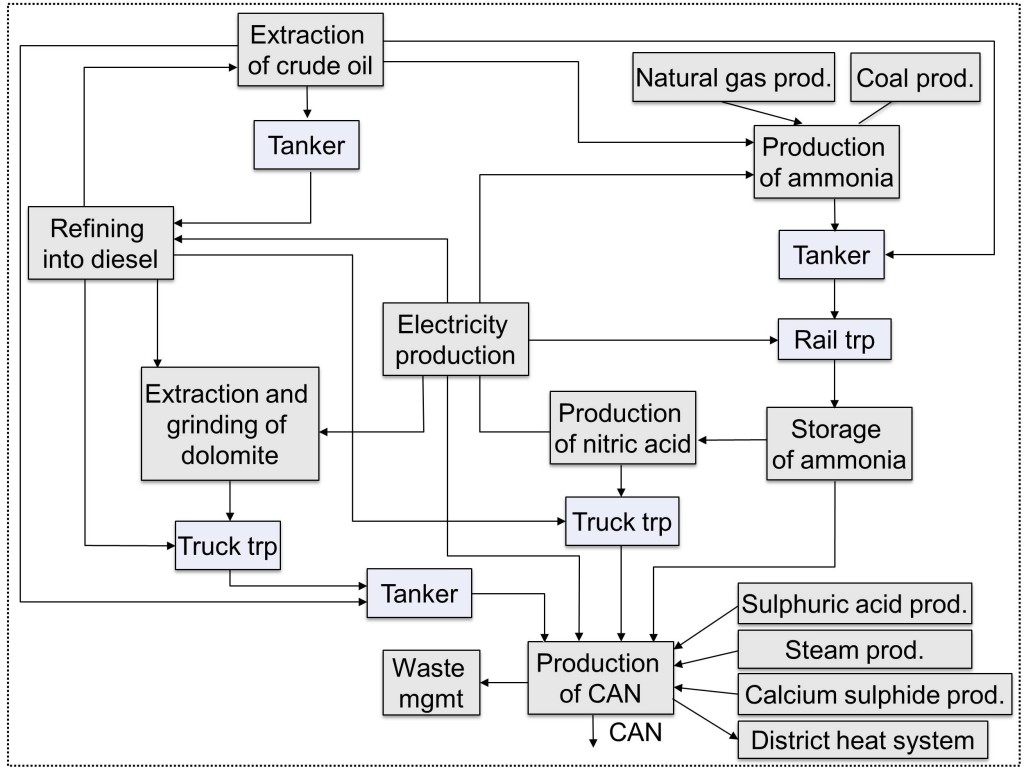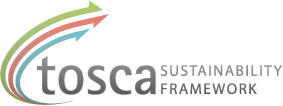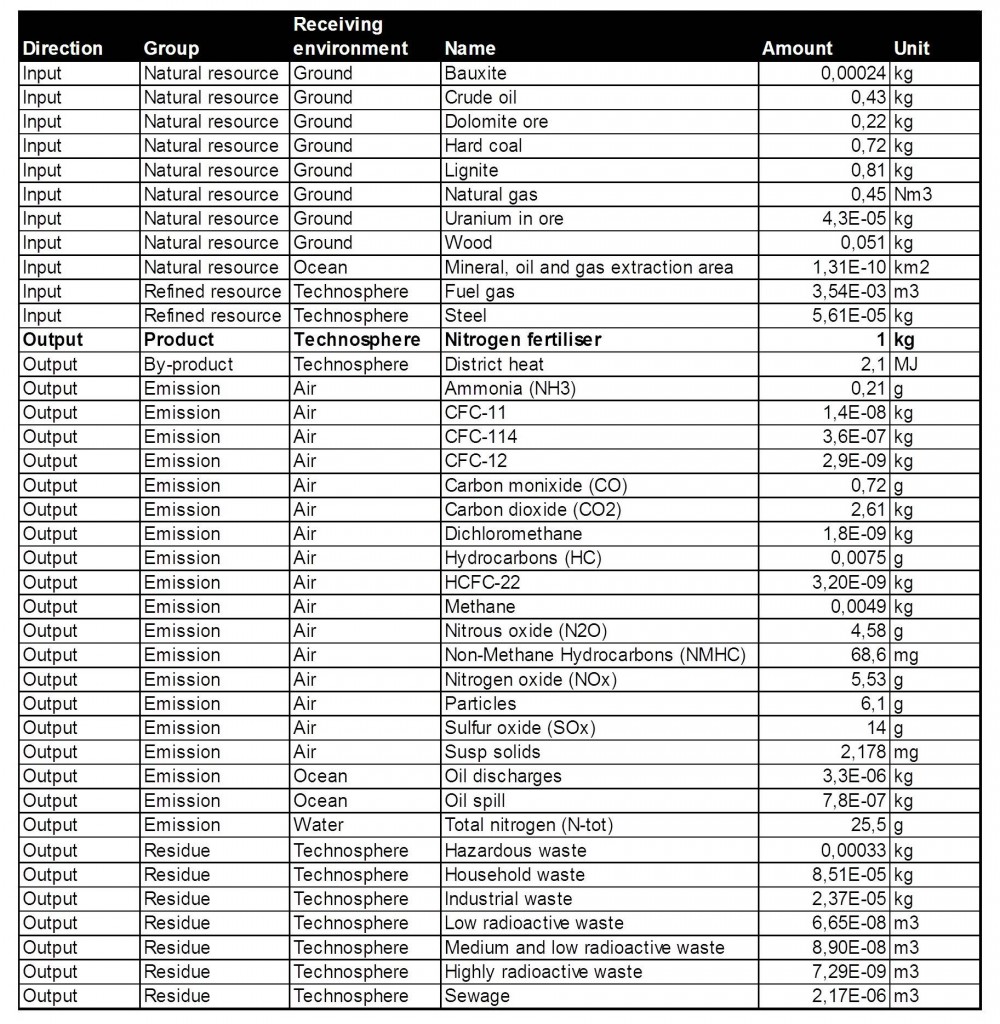Performing the inventory in the LCA study
By Ann-Christin Pålsson & Ellen Riise
In the life cycle inventory, the result for the product system is prepared, i.e. the contribution from each included part of the product system is aggregated into a total for the system as a whole. Also, the result is analysed and interpreted.
 The life cycle inventory in the LCA involves two main parts:
The life cycle inventory in the LCA involves two main parts:
- Collection of data for each unit process included in the product system, defined in the goal and scope phase. This also involves validation of the collected data, to ensure that data quality requirements are met.
- Aggregation into inventory result, i.e. aggregating the contribution from each included unit process into the result for the product system. The inventory result describes the inputs and outputs for the product system in terms of e.g. resources and emissions to air, water and ground.
Collection and validation of data
The data used as basis for the LCA has the largest importance for the usefulness of the result in terms of e.g. relevancy, accuracy and representativeness. It is usually also the most time consuming phase of the LCA. Therefore the data collection should be carefully planned and be made in line with data quality requirements defined in the “Goal and scope” phase.
The data collection in the study generally consists of the following parts (based on ISO 14044):
- Preparing for data collection
- Data collection
- Validation of collected data
- Allocation
Each part is described below.
Preparing for data collection
The preparations for data collection generally consist of the following steps:
- Identify which unit processes to collect data for
- Identify which data sources to collect data from
- Define data documentation requirements and select documentation format for all data
Each step is described below. In addition, the “Where to find support” section of this guide provides some additional guidance for the data collection.
Identify which unit processes to collect data for
The first step in the preparations for data collection is to identify which unit processes data should be collected for. This is made by using the initial flow chart of the product system developed in the Goal and scope phase. Data need to be collected for each included process in the process system. Below is an example of a product system for a nitrogen fertiliser (Calcium ammonium nitrate (CAN)), based on a study performed at SIK (the Swedish Institute for Food and Biotechnology). Note that the use and end-of-life phase is not included in the system.

Identify which data sources to collect data from
The next step is to identify and decide which data sources that should be used in the data collection. Which data sources to use depends on the goal of the study and the initial data quality requirements that have been set. You will usually need to collect data from a number of different data sources, for example:
- specific production processes, e.g. own or supplier production sites
- internal databases and reports, e.g. production and market statistics, specifications, recipes, product usage, etc.
- modelling or estimations, e.g. based on theoretical modelling of the process or based on data for production processes using similar technology, etc.
- external databases and literature, e.g. commercial LCA databases, earlier performed LCA:s, technical literature, etc.
In the preparations you will need to decide the ambition for the collection and determine for which processes in the product system to collect site specific information for; i.e. from production processes and internal databases, and for which processes you can collect and use “generic” information, i.e. from modelling or estimations or external databases and literature. The decision for data sources to use should be based on the goal and scope of the study and the quality requirements.
Define data documentation requirements and select documentation format for all data
In addition, data documentation requirements should be defined for the study. Documentation of data is important as a lot of information is collected during the LCA, and in order to keep track of all information and ensure that information is not lost along the way, it needs to be structured and documented. Structured documentation also facilitates interpretation and review of the included data and the study.
To support the work with documentation, a format for documenting the data should be designed or selected. Within ISO a format for documentation of LCI data have been developed; ISO/TS 14048. This format can be used as basis both in defining documentation requirements and for the actual documentation. Documentation requirements can be defined by selecting which information in the ISO/TS 14048 format that should be captured for the collected data; for example who is responsible for the data collection, what is the scope of the process and the data, and how have data been acquired and treated, etc.
In the data collection, it may be necessary to use data collection forms or questionnaires, for example when collecting data from suppliers. In this case, the forms or questionnaires must be properly designed, to simplify the understanding for the persons involved with the collection. Guidance on how to use and fill in the form or questionnaire may be needed.
Data collection
After the preparations, the data collection for each included process in the product system is started. For each process, data for inputs and outputs is collected concerning use of raw materials and energy, emissions to air, discharges to water and ground, produced products and co-products and generated waste. Depending on the data sources that are used, different issues are important to consider.
When collecting data for specific production processes, the data used as basis is generally compiled from different internal sources. For example, amounts for use of raw materials and energy could be collected from resource management systems, amounts of emissions to air and water could be collected from laboratory reports, amounts of waste could be collected from the amounts sent to the waste management company. This work will generally require dialogue and support from personnel responsible for the different types of information to ensure that the information is interpreted and used correctly.
In addition to specific data for the production process, internal databases and reports can be used to collect information about the studied product in the LCA. For example, product performance, usage patterns, market trends, end-of-life treatment, etc. When using such information, the applicability of the information for the study will need to be assessed, and the data may need to be remodelled or adapted before it can be used in the LCA.
For some processes it may be necessary to use data based on modelling or estimations. For example, process models can be constructed from theoretical models and descriptions concerning typical yield and performance, or by using information for a similar production technology and process. Such data can be compiled by collecting information from e.g. technical literature or experts in the specific process.
There are a number of external databases and literature available that contains LCA-data. When using information from such sources, one will need to consider the transparency of the data, i.e. whether the available information is sufficient to assess the quality and applicability of the data, if there are any costs associated with using the data, and whether there are any restrictions concerning how the data can be used in terms of copyright or secrecy.
Throughout the work with data collection it is recommended that the data is continuously documented to ensure transparency and quality of the data.
Information collected from specific production processes or from internal databases and reports can be quite business sensitive, and need therefore to be handled securely. Specific secrecy agreements may need to be set up as to how the data can be shared and handled. This will be especially important when collecting and sharing data with business partners, e.g. suppliers or customers.
Validation of data
During the work with data collection, the data need to be validated to confirm that data quality requirements have been fulfilled. There are different types of validity checks, for example by:
- Performing mass/energy balances, i.e. compare the input with the output of mass and energy according to the laws of conservation of mass and energy. This is a simple way to check the general consistency of the data and identify whether an input or output may be missing.
- Comparing with similar data, e.g. with available data from similar processes. This can be used to assess plausability of the collected data.
Depending on the result from the validation, new or additional information may need to be collected.
Often it is not possible to find all missing data or fill all datagaps. For example data for a specific flow may be missing for a specific process in the product system, or it has not been possible to obtain data for a process in the product system. Then it is important to determine and decide how to handle such missing data and data gaps.
Allocation
When collecting data for the processes in the product system, it may be necessary to allocate the inputs and outputs between different products. This may be necessary for processes that produces more than one product. In this case, the use of raw materials and energy, and the releases to air, water and land will need to be divided between the products.
According to ISO 14040 the following stepwise procedure are recommended in allocation;
- Wherever possible, allocation should be avoided for example by increasing the level of detail in the system.
- Where allocation is not avoidable, inputs and outputs should be partitioned between its different functions or products in a way that reflects the underlying physical relationships between them.
- If the latter is not possible, allocation should be carried out based on other existing relationships (e.g. in proportion to the economic value of products).
Further issues arise if the material is recycled, either directly or several times.
Aggregation into the inventory result
The second part of the inventory analysis is to compile the inventory result with the collected data. The inventory result describes the inputs and outputs to the studied product system as a whole.
The compilation of the inventory result involves (based on ISO 14044):
- Relating data to unit process and functional unit
- Data aggregation
- Refining system boundaries, if necessary
The flow chart for the product system is an important tool in the work with compiling the inventory result, and therefore the flow chart should be finalised before starting the aggregation.
If using a dedicated LCA software, parts of this work is done automatically. It is, however, possible to perform these calculations using pen and paper, and calculator or ordinary spreadsheet software.
Relating data to unit process and functional unit
The first step in the aggregation is to structure and prepare the collected data for the unit processes included in the product system, by first relating data to unit process and then normalise the data to the functional unit.
Relating data to unit process involves determining the reference flow for each unit process and relating the data for inputs and outputs to this flow. The reference flow for each included unit process have usually already been determined in the work with constructing and finalising the flow chart, as this is the flows that connects the processes with each other, also named intermediate product flows. All inputs of raw material and energy and all outputs for each unit process should be related to the specific reference flow that have been determined. In this work, it may be necessary to allocate the inputs and outputs between products (see above).
The normalisation of data to the functional unit involves scaling the inputs and outputs to each unit process to the functional unit defined for the study. In practice, this means that the contribution from each unit process to the functional unit is determined.
Basically, this normalisation is performed according to the following:
1. Calculate scaling factors of each unit process by using the flow chart and the inputs and outputs data for each included unit process. The scaling factors represents the amount of intermediate product flows needed to produce the functional unit. Note the scaling factor in the flow chart. Be careful about situations where e.g. electricity or other products are used in several included unit processes. Scaling factors for transports are usually derived by multiplying the amount of material transported with the distance that the material is transported.
2. Scale each unit process to the functional unit. The scaling factors are used to scale all inputs and outputs for each included unit process. This is done by multiplying the inputs and outputs for each unit process with the corresponding scaling factor. The scaled unit processes delivers the amount of material needed to produce the functional unit.
Aggregation
The next step in the inventory is to aggregate the inputs and outputs for all included unit processes. In practice this means using the data normalised to the functional unit (i.e. the scaled unit processes) and aggregate inputs and outputs where the substance and environmental consequence are the same. For example, CO2 emissions to air from all included unit processes are added together into the total CO2 emission to air for the product system. This is the inventory result for the product system.
An example of how the inventory result may look like for the example of product system for a nitrogen fertiliser (see picture above) is given in the table. Please note that this is only a fictitious example.
Refining system boundaries
Having finalised the inventory results, a sensitivity analysis should be performed to assess the significance of the result and the input data. The sensitivity analysis can e.g. involve an analysis of which parts of the life cycle that have a large contribution to the overall results and whether the data used as basis for these parts is of sufficient quality to meet the goal of the study. Based on the results from this, it may be necessary to go back to the goal and scope and refine the system boundaries. This could for example involve improving some data or changing the scope of the study. This reflects the iterative nature of LCA.


